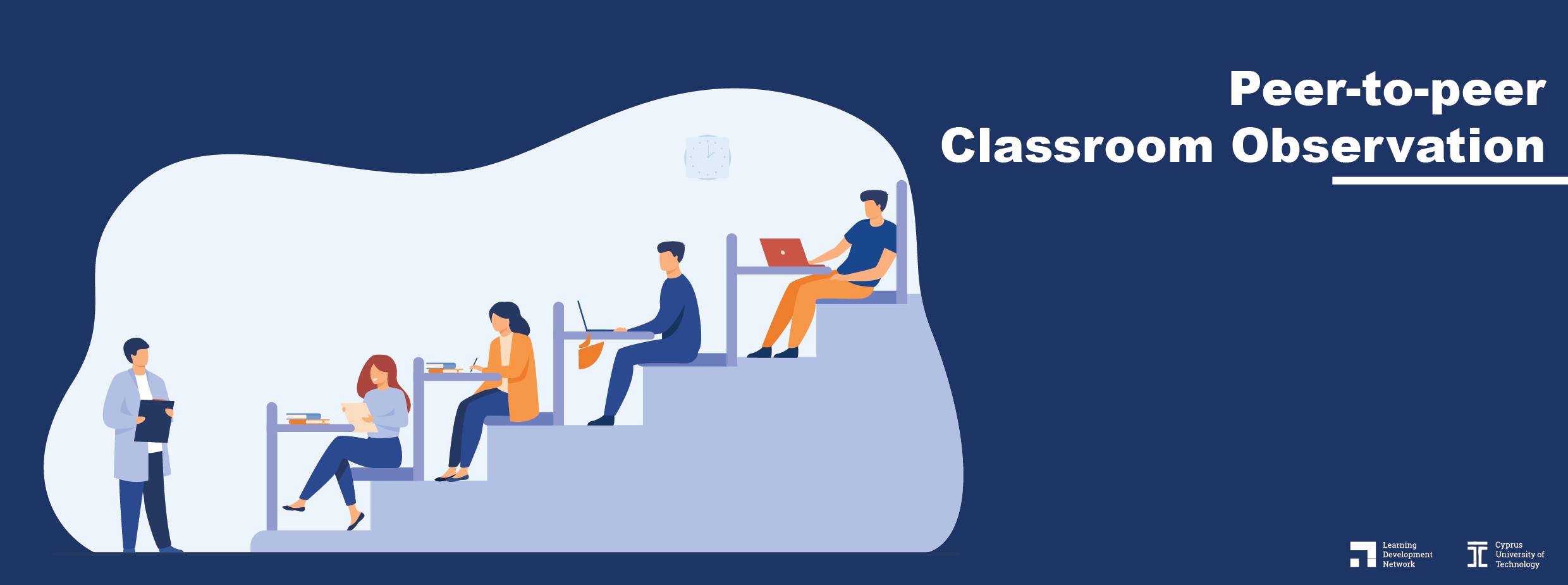
“Peer Classroom Observation”
“Peer Classroom Observation” – Action’s objective
The objective of the “Peer Classroom Observation” Action is for academics to receive feedback on their educational practices from peers. The aim is to improve teaching practices and strategies, at an academic level, with an emphasis on student-centered teaching. The feedback from a third observer can provide the academic with best practice data and tools, which can be beneficial to both students and academics.
Where is the Action “Peer Classroom Observation” based on?
Feedback from Peers
Recent studies indicate that «The wider uptake of peer review of teaching has the potential to make a valuable contribution to the advancement of higher education — among its various benefits, peer review can play an important role in assisting individuals to enhance their teaching, in recognising and rewarding skills and achievements in teaching, and in developing individuals’ academic careers. The more widespread and systematic the use of peer review of teaching, the greater the opportunities to enhance the quality of teaching and learning in universities.» (Devlin & Bell, 2008, p. 4).
What are the benefits of the “Peer Classroom Observation”Action?
Recent research studies have shown that peer observation is a useful tool for encouraging academics to reflect on their own teaching practices, thus improving the quality of the offered teaching experience (Bell & Mladenovic 2008). This applies to all courses, regardless of the subject being taught. In summary, the benefits of peer feedback are:
1. It enhances teaching and learning experiences.
2. It is a fundamental tool for the development of teaching, complementing the feedback provided by students.
3. It increases the quality of teaching and learning.
4. It utilizes the educational know-how and judgment of academics in their fields.
5. It provides feedback that confirms good practices and suggests areas where development can be useful.
Achievement of Sustainable Development Goals (SDG) in Quality Education
The proposed Action will assist academics and consequently the Cyprus University of Technology in achieving the United Nations’ Sustainable Development Goals, in particular the fourth Goal, entitled “Quality Education”. Specifically, it can contribute to the achievement of the following targets:
4.4: By 2030, substantially increase the number of youth and adults who have relevant skills, including technical and vocational skills, for employment, decent jobs and entrepreneurship.
4.7: By 2030, ensure that all learners acquire the knowledge and skills needed to promote sustainable development, including, among others, through education for sustainable development and sustainable lifestyles, human rights, gender equality, promotion of a culture of peace and non-violence, global citizenship and appreciation of cultural diversity and of culture’s contribution to sustainable development.
Implementation process of the “Peer Classroom Observation” Action
Feedback on teaching practices will be provided by members of the Learning Development Network. Where possible, the observers will belong to the same Faculty as the academic who requests peer feedback via this Action.
Peer observation is proposed to be implemented on a voluntary basis once a year. All teaching observations by peers will be confidential and documented in order to support academics’ teaching practices.
After the academic applies for a peer classroom observation to the Learning Development Network, a four-stage process will be implemented as shown below:

Diagram 1. Peers Observation process (Bell, 2002)
Stages of the “Peer Classroom Observation” Action
1. The academic requests teaching feedback by clicking here.
2. Prior to the observation session, the observer and the academic discuss the purpose/subject of the lesson/course and the issues they would like the focus of the observation to be on.
3. Observation session.
4. After the session, academics and observers discuss topics related to the adoption of good practices and future teaching strategies.
5. The observer submits a detailed report to the academic. Where possible, the academic may request repeated feedback within the same or upcoming semester.
Standardized peer observation forms are handed out to be completed by the Academic (Pre-observation Form) and the Observer (Observation Form).
Βιβλιογραφία – References
Bell, M., & Cooper, P. (2013). Peer observation of teaching in university departments: A framework for implementation. International Journal for Academic Development, 18(1), 60-73.
Bell, A., & Mladenovic, R. (2008). The benefits of peer observation of teaching for tutor development. Higher Education, 55(6), 735-752. https://link.springer.com/content/pdf/10.1007/s10734-007-9093-1.pdf
Bell, M. (2002). Peer Observation of Teaching in Australia, Higher Education Academy Report. http://www.heacademy.ac.uk/resources/detail/resource_database/id28_Peer_Observation_of_Teaching_in_Australia.
Bell, M. (2001). Supported reflective practice: a programme of peer observation and feedback for academic teaching development. International Journal for Academic Development, 6(1), 29-39.
Devlin Μ. and Bell M. (2008). Peer review of teaching in Australian higher education: a handbook to support institutions in developing and embedding effective policies and practices. Publisher: voced.edu.au. ISBN 9780734040466 (electronic/internet copy)
Fletcher, J. A. (2018). Peer observation of teaching: A practical tool in higher education. The Journal of Faculty Development, 32(1), 51-64. https://lib.dr.iastate.edu/cgi/viewcontent.cgi?article=1023&context=fshn_hs_pubs
Siddiqui, Z. S., Jonas-Dwyer, D., & Carr, S. E. (2007). Twelve tips for peer observation of teaching. Medical teacher, 29(4), 297-300.
Sullivan, P. B., Buckle, A., Nicky, G., & Atkinson, S. H. (2012). Peer observation of teaching as a faculty development tool. BMC medical education, 12(1), 1-6.
